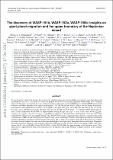The discovery of WASP-151b, WASP-153b, WASP-156b : insights on giant planet migration and the upper boundary of the Neptunian desert
Abstract
To investigate the origin of the features discovered in the exoplanet population, the knowledge of exoplanets' mass and radius with a good precision is essential. In this paper, we report the discovery of three transiting exoplanets by the SuperWASP survey and the SOPHIE spectrograph with mass and radius determined with a precision better than 15 %. WASP-151b and WASP-153b are two hot Saturns with masses, radii, densities and equilibrium temperatures of 0.31^{+0.04}_{-0.03}MJ, 1.13^{+0.03}_{-0.03} RJ, 0.22^{-0.03}_{-0.02} ρJ and 1,290^{+20}_{-10} K, and 0.39^{+0.02}_{-0.02} MJ, 1.55^{+0.10}_{-0.08} RJ,0.11^{+0.02}_{-0.02} ρJ and 1, 700^{+40}_{-40} K, respectively. Their host stars are early G type stars (with magV ~ 13) and their orbital periods are 4.53 and 3.33 days, respectively. WASP-156b is a Super-Neptune orbiting a K type star (magV = 11.6) . It has a mass of 0.128^{+0.010}_{-0.009} MJ, a radius of 0.51^{+0.02}_{-0.02} RJ, a density of 1.0^{+0.1}_{-0.1} ρJ, an equilibrium temperature of 970^{+30}_{-20} K and an orbital period of 3.83 days. WASP-151b is slightly inflated, while WASP-153b presents a significant radius anomaly. WASP-156b, being one of the few well characterised Super-Neptunes, will help to constrain the formation of Neptune size planets and the transition between gas and ice giants. The estimates of the age of these three stars confirms the tendency for some stars to have gyrochronological ages significantly lower than their isochronalages. We propose that high eccentricity migration could partially explain this behaviour for stars hosting a short period planet. Finally, these three planets also lie close to (WASP-151b and WASP-153b) or below (WASP-156b) the upper boundary of the Neptunian desert. Their characteristics support that the ultra-violet irradiation plays an important role in this depletion of planets observed in the exoplanet population.
Citation
Demangeon , O D S , Faedi , F , Hébrard , G , Brown , D J A , Barros , S C C , Doyle , A P , Maxted , P F L , Collier Cameron , A , Hay , K L , Alikakos , J , Anderson , D R , Armstrong , D J , Boumis , P , Bonomo , A S , Bouchy , F , Haswell , C A , Hellier , C , Kiefer , F , Lam , K W F , Mancini , L , McCormac , J , Norton , A J , Osborn , H P , Palle , E , Pepe , F , Pollacco , D L , Prieto-Arranz , J , Queloz , D , Ségransan , D , Smalley , B , Triaud , A H M J , Udry , S , West , R & Wheatley , P J 2018 , ' The discovery of WASP-151b, WASP-153b, WASP-156b : insights on giant planet migration and the upper boundary of the Neptunian desert ' , Astronomy & Astrophysics , vol. 610 , A63 . https://doi.org/10.1051/0004-6361/201731735
Publication
Astronomy & Astrophysics
Status
Peer reviewed
ISSN
0004-6361Type
Journal article
Description
O.D.S.D acknowledges the support from Fundação para a Ciência e a Tecnologia (FCT) through national funds and by FEDER through COMPETE2020 by grants UID/FIS/04434/2013&POCI-01-0145-FEDER-007672 and PTDC/FIS-AST/1526/2014&POCI-01-0145-FEDER-016886. SCCB also acknowledges support from FCT through Investigador FCT contract IF/01312/2014/CP1215/CT0004. CAH was supported by STFC under grant ST/P000584/1. A.S.B. acknowledges funding from the European Union Seventh Framework programme (FP7/2007-2013) under grant agreement No. 313014 (ETAEARTH). D.J.A.B acknowledges funding from the UKSA and the University of Warwick. The SuperWASP Consortium consists of astronomers primarily from University of Warwick, Queens University Belfast, St Andrews, Keele, Leicester, The Open University, Isaac Newton Group La Palma and Instituto de Astrofísica de Canarias. The SuperWASP-N camera is hosted by the Issac Newton Group on La Palma and WASPSouth is hosted by SAAO. We are grateful for their support and assistance. Funding for WASP comes from consortium universities and from the UK’s Science and Technology Facilities Council. The research leading to these results has received funding from the European Community’s Seventh Framework Programmes (FP7/2007-2013 and FP7/2013-2016) under grant agreement number RG226604 and 312430 (OPTICON), respectively. This work is based on radial velocity observations made at Observatoire de Haute Provence (CNRS), France and at ESO La Silla in (Chile) with the CORALIE Echelle spectrograph mounted on the Swiss telescope. We thank the staff at Haute-Provence Observatory. TRAPPIST is funded by the Belgian Fund for Scientific Research (Fond National de la Recherche Scientifique, FNRS) under the grant FRFC 2.5.594.09.F, with the participation of the Swiss National Science Fundation (SNF). The Swiss Euler Telescope is a project financed by the Swiss National Science Foundation. The Liverpool Telescope is operated on the island of La Palma by Liverpool John Moores University in the Spanish Observatorio del Roque de los Muchachos of the Instituto de Astrofisica de Canarias with financial support from the UK Science and Technology Facilities Council. The Aristarchos telescope is operated on Helmos Observatory by the Institute for Astronomy, Astrophysics, Space Applications and Remote Sensing of the National Observatory of Athens. This paper includes data collected by the K2 mission. Funding for the K2 mission is provided by the NASA Science Mission directorate. Used Simbad, Vizier, exoplanet.eu. The authors also want to thank Pedro Figueira, Nuno Santos and Mahmoud Oshagh for fruitful discussions and Joao Faria for his Python figure stylerCollections
Items in the St Andrews Research Repository are protected by copyright, with all rights reserved, unless otherwise indicated.

